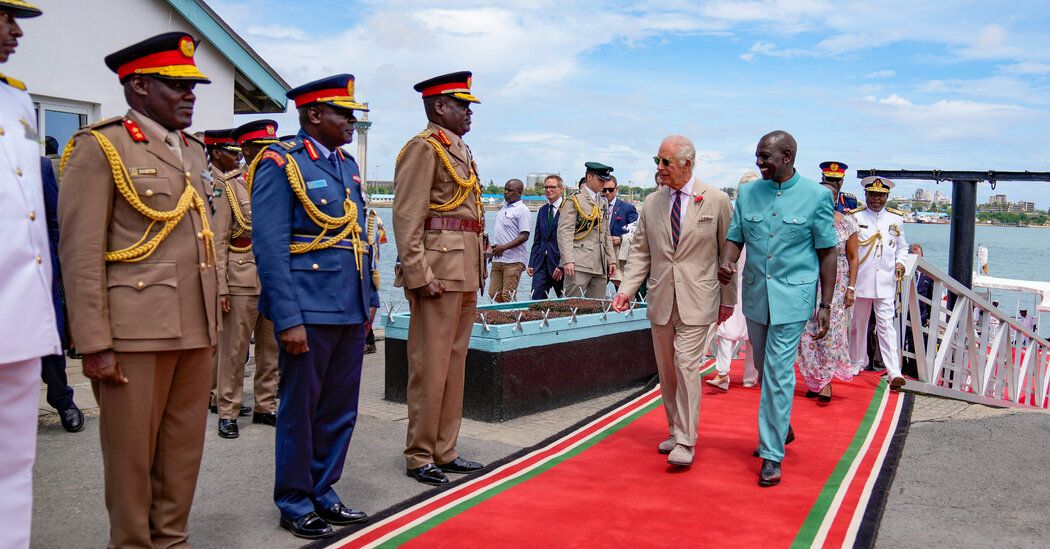[ad_1]
The Kaunda suit has become a choice attire for African celebrities, elders and politicians in recent years, including one particularly high-profile convert — Kenya’s president, William Ruto.
A single-breasted safari jacket with short or long sleeves and patch pockets — often worn with matching pants — it was initially made popular in the 1960s by Kenneth Kaunda, the first post-colonial president of Zambia.
But the Kaunda suit was banned from the Kenyan Parliament this week, along with other forms of traditional African dress and tightly-fitted clothing for women. The Kenyan speaker of Parliament decreed that such attire violates the parliamentary dress code — which largely conforms to a modern Western working wardrobe.
A fashion trend like the Kaunda suit “does not accord with the seriousness of the proceedings of the house and its committees,” Moses Wetangula, the speaker of the Parliament, said in a speech on Tuesday.
Proper dress for men entering the parliamentary chambers, he said, is “a coat, collar, tie, long-sleeved shirt, long trousers, socks and shoes or service uniform.”
The move prompted an outcry on social media, with many asking why proudly African attire would be outlawed in an African government building in favor of the suits and ties associated with colonial powers.
“Truly, colonialism is still deeply embedded in our minds,” Abdullahi Halakhe, a Kenyan human rights activist, said in a post in Swahili on X, formerly Twitter. He included a link to a story with a photo of the Parliament’s speaker wearing the white wig and robe that is a holdover from British colonial days.
The flap comes as Afrocentric fashion is gaining huge traction on the continent and further afield — on runways and movie screens and by shoppers drawn to Black culture and style.
The Kenyan speaker also banned hats and caps in Parliament, and said that women should wear business, formal, or smart casual clothing with skirts and dresses below the knee. Sleeveless blouses were prohibited, he added. The rules apply to guests and journalists visiting Parliament, as well as politicians.
“I gave these directions conscious of the fact that they might bring discomfort to some of you,” said Mr. Wetangula, 67. “However, discomfort is necessary for the convenience and security of members and good order.”
One of the most prominent targets of the edict did not appear to be listening.
A day after the announcement in Parliament, President Ruto — who publicly wore his first Kaunda suit as president in June this year — met the NBA Africa chief executive while wearing a brown Kaunda suit. On Thursday, he attended a government function while wearing a version in sky blue. He has grabbed attention when sporting a Kaunda suit in pink.
Many modern African leaders have shown awareness that voters appreciate politicians willing to openly embrace their cultural heritage and traditional attire. Nelson Mandela, as president of South Africa, wore his signature “Madiba” shirts in bold prints, while the former Nigerian president Goodluck Jonathan often wore a wide-brimmed fedora-style hat beloved by tribal chiefs in his region.
In Rwanda, President Paul Kagame wears clothing made by Rwandan designers to popularize the “Made in Rwanda” campaign.
Mr. Kaunda of Zambia, who led his Southern African nation from 1964 to 1991, adopted the short-sleeved suit as a symbol of African freedom and independence. The style had early roots in Australia and strong similarities to a Chinese silhouette made popular by Chairman Mao.
In banning the Kaunda suits, Mr. Wetangula, the Kenyan parliamentary speaker, called them “Mao Zedong coats.”
The speaker is a former senator who served as foreign affairs minister a decade ago, until he resigned following corruption allegations. He has been an ally of Mr. Ruto, 56, a former vice president who rose to fame as a shrewd political operator and businessman. He assumed office in September last year, after winning a tight election.
The kerfuffle over the dress code in Parliament comes amid rising public anger and protests over his administration’s performance, especially over the spiking cost of food and fuel and increasing taxes.
Mr. Ruto’s tailor, Ashok Sunny, said the president’s penchant for Kaunda suits came from a desire to promote local manufacturing and designers.
“He is showing that we don’t have to wear suits all day. We can wear the African cut representing the African look,” Mr. Sunny said in an interview this year with TV47 in Kenya. He added, “They call it the dictator look most of the time because most of the old dictators used to like the Kaunda suit.”
It is not the first time that sartorial choices have roiled Kenya’s parliament.
Mike Sonko, a former senator and Nairobi governor, was ejected from Parliament in 2011 for wearing sunglasses and ear studs. Mr. Sonko, a flamboyant politician known for his lavish lifestyle, decried the move at the time, saying he was dressing like the country’s youth.
[ad_2]
Source link
